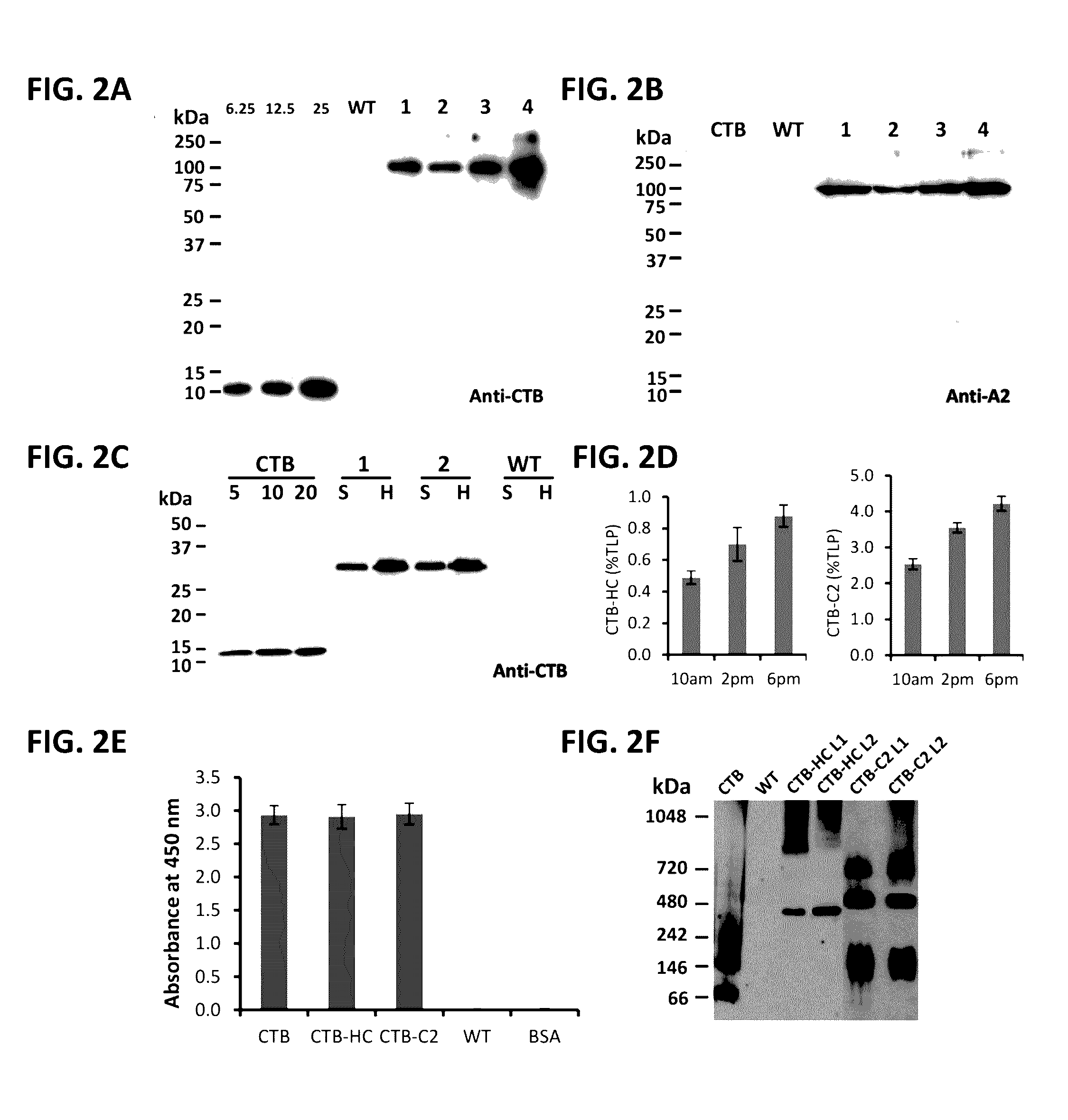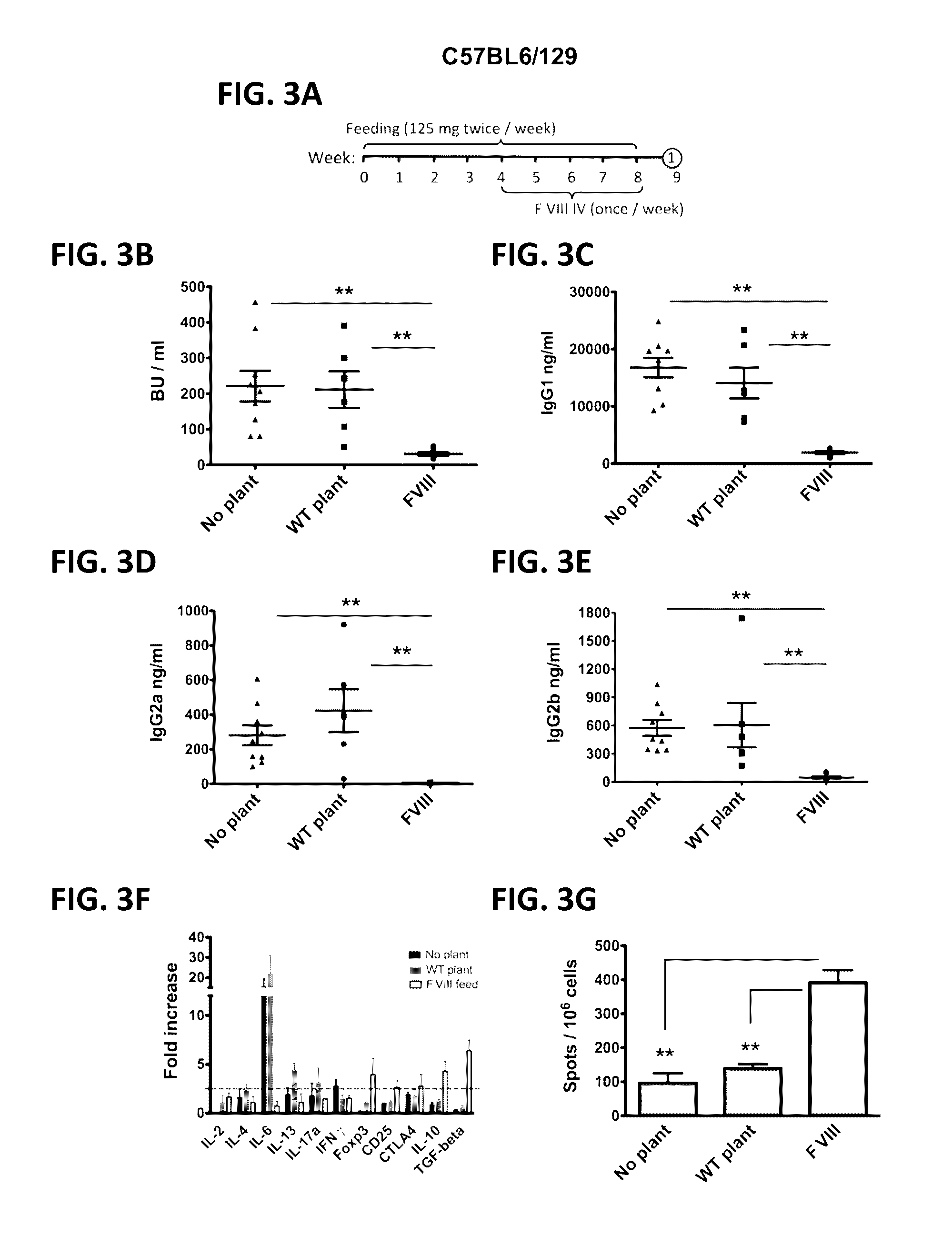Compositions and methods for suppression of inhibitor formation against coagulation factors in hemophilia patients
a technology of coagulation factor and inhibitor, which is applied in the field of recombinant plants and the treatment of disorders, can solve the problems of coagulation defect, complicating treatment, and increasing morbidity and mortality of this disease, and achieve the effects of suppressing inhibitor formation, reducing inhibitor formation against fviii, and increasing expression in plant chloroplasts
- Summary
- Abstract
- Description
- Claims
- Application Information
AI Technical Summary
Benefits of technology
Problems solved by technology
Method used
Image
Examples
example i
Oral Administration of FVIII to Induce Tolerance
[0071]While there are currently no prophylactic protocols against inhibitor formation in patients, preclinical experiments in murine models of hemophilia A have provided proof-of-principle that preventive immune tolerance to FVIII can be established.6-11 However, such protocols utilize genetic manipulation or immune suppressive drugs, raising safety concerns for translation to human treatment. In contrast, oral tolerance could be a more readily acceptable form of prophylactic tolerance induction and may be more readily tested in clinical trials.12,13 However, effective tolerogenic delivery of coagulation factor antigen to the gut-associated lymphoid tissue (GALT) is a challenge.14 In accordance with the present invention, we have developed a cost-effective system for production of high levels of protein in chloroplasts of transplastomic tobacco plant cells, which provide bioencapsulation of the antigen through the cellulose containing ...
example ii
[0097]Generation of lettuce transplastomics to induce oral tolerance to FVIII In order to facilitate clinical translational studies, antigens should be developed in an edible crop. Therefore, we generated lettuce (Lactuca sativa) CTB-C2 transplastomic plants. The lettuce chloroplast expression vector pLs-CTB.C2 was created by introducing lettuce flanking sequences 16S / trnI and trnA / 23S, and 5′ UTR and promoter of psbA gene from lettuce (FIG. 9A). Transplastomic plants were obtained after 3-4 months of selection and regeneration following bombardment of lettuce leaves. Southern blot analysis indicated that homoplasmy was achieved in most transplastomic lines (FIG. 9B). Up to 1.7% TLP (or 102 μg / g fresh leaves) of CTB-C2 fusion protein was expressed in lettuce chloroplasts as observed in western blot analysis (FIG. 9C). The pentamer form of lettuce-made CTB-C2 was also verified by GM1 binding assay and by blue native gel electrophoresis / immunoblot analysis (FIGS. 9D and 9E). No cleave...
example iii
Expression of FIX in Lettuce and Prevention of Inhibitor Formation Against FIX in Hemophilia B Dogs by Administering Lettuce CTB-FIX
[0107]In this Example, FIX-transplastomic lettuce plants in an edible system ideal for oral delivery are described. We also describe evaluation of therapeutic efficacy in animal models using a wide dose range and FIX product stability.
[0108]To construct the lettuce chloroplast CTB-FIX expression vector, PCR was first performed to amplify the CTB-FIX fusion gene with the primer set NdeI-CTB-Fw (5′ TTCATATGACACCTCAAAATATTACTGATT 3′, the underlined nucleotides represent the start codon of CTB fusion tag) and XbaI-FIX-Rv (5′ GATCTAGATTAAGTGAGCTTTG TTTTTTCCT 3′, the underlined nucleotides indicate the stop codon of FIX) from a template plasmid pLD CTB-FFIX20. The CTB-FIX PCR products were cloned into pCR-Blunt II-TOPO Vector (Life Technologies Co., Carlsbad, Calif.). After verification of nucleotide sequence, the NdeI-CTB—FIX-XbaI fragment was subcloned into...
PUM
| Property | Measurement | Unit |
|---|---|---|
| Fraction | aaaaa | aaaaa |
| Immunogenicity | aaaaa | aaaaa |
| Coagulation enthalpy | aaaaa | aaaaa |
Abstract
Description
Claims
Application Information
 Login to View More
Login to View More - R&D
- Intellectual Property
- Life Sciences
- Materials
- Tech Scout
- Unparalleled Data Quality
- Higher Quality Content
- 60% Fewer Hallucinations
Browse by: Latest US Patents, China's latest patents, Technical Efficacy Thesaurus, Application Domain, Technology Topic, Popular Technical Reports.
© 2025 PatSnap. All rights reserved.Legal|Privacy policy|Modern Slavery Act Transparency Statement|Sitemap|About US| Contact US: help@patsnap.com



